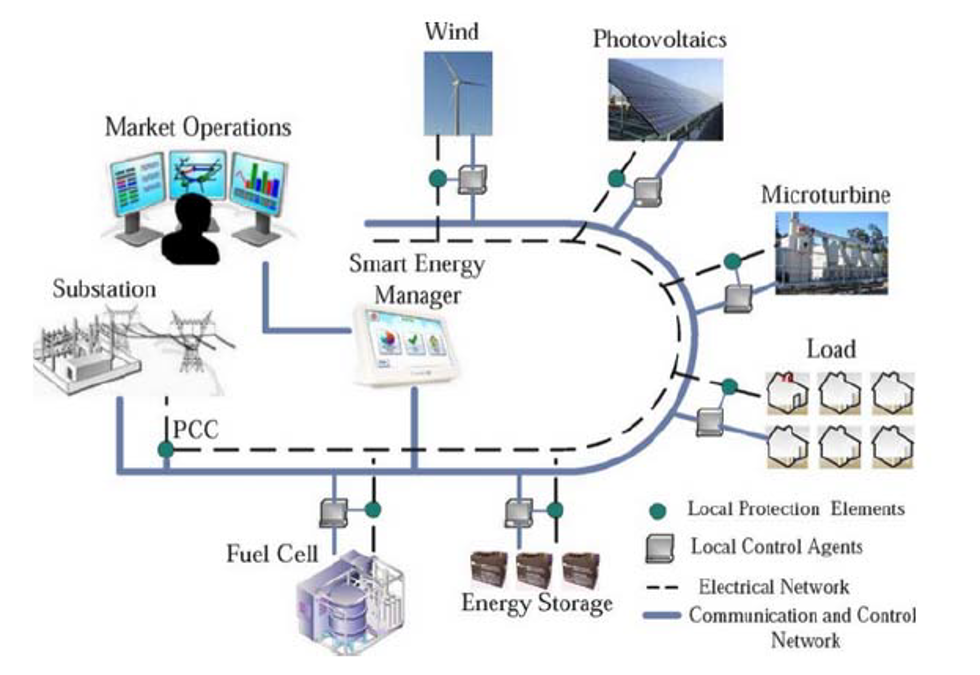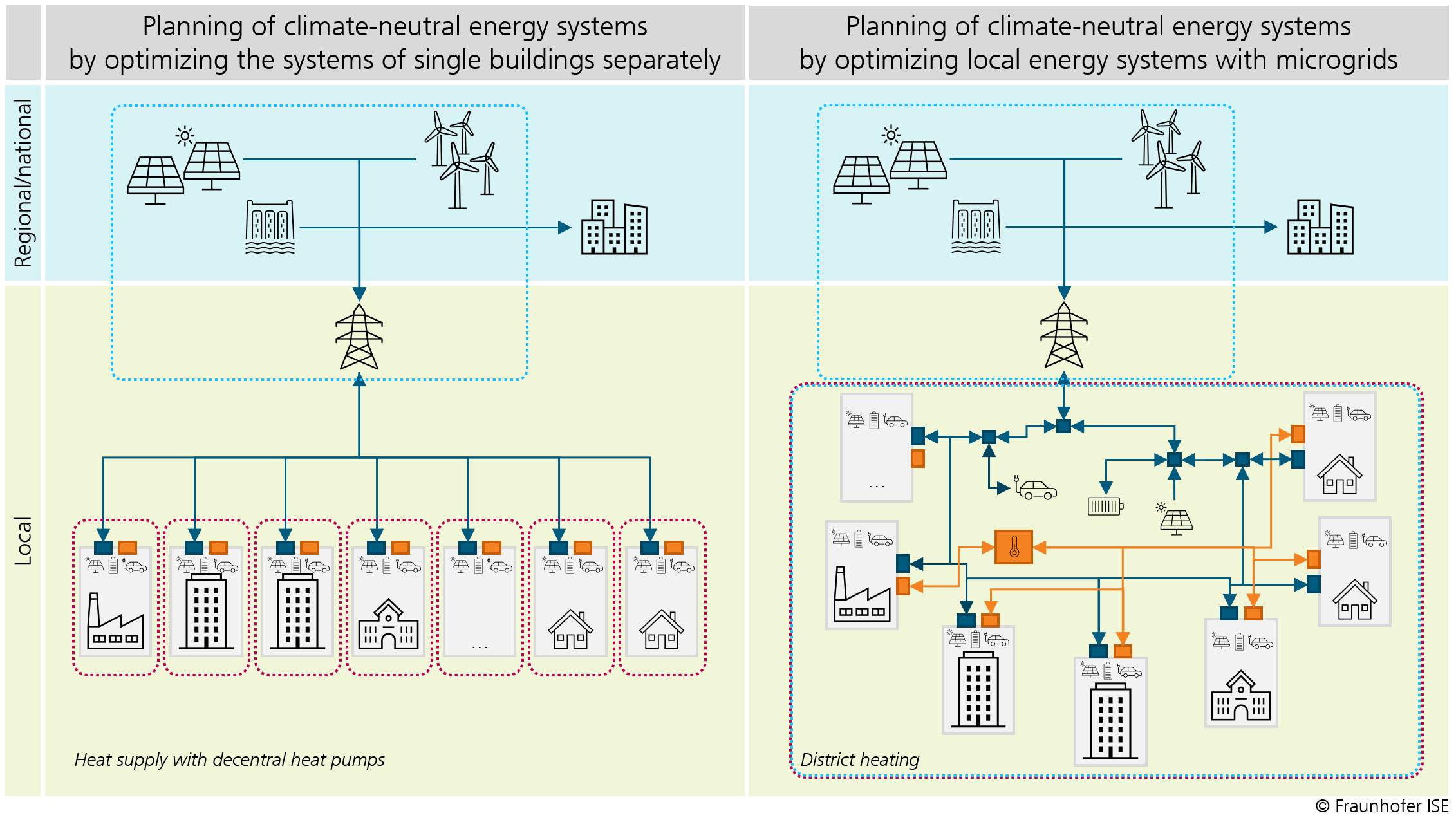Microgrid is usually understood as sub-area of an electricity distribution network that is organized and operated independently but is connected to the public electricity grid. Several energy producers and consumers are connected to the microgrid, whereby its expansion is usually limited to campus, several buildings, or a neighborhood due to the limitations of the regulatory framework. The microgrid has an intelligent control system and optimizes operation in such a way that the highest possible proportion of self-sufficiency is achieved with local renewable energies and the purchase and feed-in of electricity is designed to be as system-serving as possible for the public grid.
In microgrids, mostly photovoltaic systems and CHP units (e.g. with biogas) are used for power generation combined with stationary batteries. Controllable loads are usually heat pumps that use heat or cold storage as a buffer, as well as an e-mobile charging infrastructure that enables controlled charging and discharging of electric vehicles. Demand-side management can be used to tap further flexibility potential.
The advantages of microgrids are the locally optimised climate-neutral energy supply solution with lower costs for consumers, as grid charges and other levies are avoided. The possibilities of operating a microgrid coupled to the public electricity grid and the economic advantages that can be achieved depending on the regulatory framework conditions, which differ from country to country.

Microgrids reduce GHG emissions since a climate-neutral energy supply is enabled by the microgrid. The access to clean and affordable energy is simplified, and the technological readiness is further increased by micro grids. Furthermore, micro grids support the sharing economy since the prosumers first exchange the generated energy with the other prosumers.
Microgrids are a possibility to develop solutions for neighborhoods. The participation of the citizens living in the neighborhood is necessary. Energy communities could provide an organizational framework to provide microgrids. However, microgrids are also an approach to develop and test new business models (energy sharing on the local level) and could become pilots to implement climate neutral areas which could be then distributed to other areas of the climate neutral cities.
Micro grids are local grid units to which the end consumers are connected. There is no uniform definition of micro grids. In general, however, two types can be distinguished:
- A. Micro grids that are part of the public electricity grid and are subject to its regulation. Within this regulatory framework, local energy markets can be established in the micro grid to a limited extent, for example.
- B. Micro grids, which are separated from the public electricity grid by regulation and are not subject to its regulation. This can enable significant cost advantages, but these depend on the specific framework conditions.

Figure: A microgrid introduces an additional level of operation and optimisation into the energy system at the local level
In the following, microgrids are described that are local grid areas and are operated independently of the public electricity grid, but are connected to the electricity grid (Type B). They require the following prerequisites:
- National energy legislation allows microgrids and defines the framework conditions under which they can be operated. In Germany, for example, so-called customer grids are possible, which are not subject to the rules of the regulated energy grid (§ 3 no. 24a EnWG). However, these are only possible within the following limits. Firstly, they must be located in a spatially coherent area. Secondly, they must be connected to an energy supply grid or to a generation plant. Thirdly, they must be insignificant for ensuring effective and undistorted competition in the supply of electricity and gas, and fourthly, they must be made available free of charge and on a non-discriminatory basis to any person, irrespective of the choice of energy supplier, for the purpose of supplying the connected final consumers by means of through-transmission. The limits of these regulations are not clearly defined. For example, some housing associations have set up microgrids as customer grids for their large residential buildings. A court has ruled that no more than 100 consumers should be connected to the customer grid and no more than 1,000 MWh of electricity should be passed through in order to be insignificant for competition. It is further significant that the requirement of free choice of an energy supplier necessitates detailed accounting of electricity volumes.
- Contractual issues: if the land on which the microgrid is installed belongs to more than one owner, agreement must be reached on the installation and operation of the microgrid, and appropriate contracts must be concluded. For example, multi-family houses owned by a housing company, where the rented flats are supplied via the microgrid, are well suited.
- A business model for the operation of the microgrid must be in place that also makes the operation economically advantageous. Whether this is the case depends, among other things, on the energy consumption and the load profiles of the consumers in the microgrid, as well as the possibilities of generating electricity cost-effectively with renewable energies on site and consuming it directly. Furthermore, the necessary administrative and billing costs must not be too high.
- A competent service company is needed to efficiently organise the operation of the microgrid and its facilities and to professionally handle the administration and billing in accordance with the legal requirements.
- Enabling conditions: Decisive for the possibilities of implementing independently operating microgrids and their economic and ecological advantages are their framework conditions, which are set by national energy legislation.
Implementing a microgrid is easiest when developing new neighbourhoods, especially if the site is owned by a developer. The implementation of a microgrid is also possible for larger building ensembles of an owner with many tenants. In many other cases, the organisational and other barriers are relatively large.
Important for a successful implementation of a microgrid is a professional planning and examination of the energetic, economic and legal aspects. Appropriate experts must be involved in each case.
Measures to increase self-sufficiency in renewable energy and reduce energy costs could be adverse to the surrounding energy system. By organising itself and separating itself organisationally and operationally from the surrounding energy system, a microgrid may make it more difficult to find common solutions, e.g. at the neighbourhood or city level, which could be beneficial for the energy transition as a whole.
Within the microgrid, there is a risk that business models (e.g. local energy trading) turn out to be not as advantageous in real operation as expected, if e.g. the energy demand is lower than expected, the generation of renewable energy is possible to a lesser extent or is more expensive than expected, the operating and administrative costs are higher than calculated or the regulatory framework changes and expected modes of operation are no longer possible.
- https://microgridknowledge.com/microgrid-defined/
- https://www.alpine-space.org/projects/alpgrids/en/home
- https://www.delta-ee.com/blog/will-microgrids-become-increasingly-important-in-the-european-energy-sector/
- https://www.researchgate.net/publication/270568142_Analysis_of_European_policies_and_incentives_for_microgrids
- https://new.siemens.com/global/en/products/energy/energy-automation-and-smart-grid/microgrid.html
- https://microgrid-symposiums.org/
Microgrids are a concept to achieve the strengthening of the role of on-site energy supply. The successful implementation of a microgrid can be measured with the following indicators:
- Increased share of renewable energy self-sufficiency: microgrids aim to harness the use of local renewable energy potential available on-site in the microgrid. This is achieved through the use of electricity and heat storage, sector coupling through the use of electricity for heat supply and mobility needs, the control of loads through controlled charging of electric vehicles or the use of demand side management as well as an intelligent energy management system. In addition, there can be own marketplaces and trading mechanisms.
- Reduced energy costs for connected consumers: to energy costs of connected consumers can be reduced by using local resources, adapting the energy system to local needs, reducing the transport of energy over long distances and avoiding taxes, fees and charges.
The following steps are necessary to implement a microgrid:
- Development of an energy concept for the micro grid based on defined goals for the project (e.g. high degree of self-sufficiency with renewable energies, lower energy costs, etc.), evaluation of the possible energy system design and the achievable results.
- Investigation of the business models taking into account the regulatory framework. For this purpose, a legal expert should be involved who knows the local national regulations for the operation of local electricity grids but also, for example, of local electricity markets and renewable energy communities. Development of an optimised business model taking into account the developed energy concept. 3.
- Conceptual design of the operational implementation of the microgrid in terms of legal form, organisational structures, definition of stakeholders (owner, organiser, operator, members, consumers, etc.) and technical requirements for implementation. For example, the establishment of a local energy market requires a local trading platform and software for intelligent energy management, which have been developed in recent years in several research projects, including on a blockchain basis.
- Setting up the legal entity, organisational structures and implementation of the micro grid.
Only a few micro grid projects are implemented in Europe yet.
- https://pebbles-projekt.de/en/
- https://www.bable-smartcities.eu/explore/solutions/solution/smart-microgrids.html
- https://www.researchgate.net/publication/330367382_Design_of_a_Microgrid_Local_Energy_Market_on_a_Blockchain-Based_Information_System
- https://www.siemens.com/global/en/company/stories/infrastructure/2020/microgrid-project-in-vienna.html
- https://drawdown.org/solutions/microgrids
The term Microgrid is rather used in the USA to describe the concept of local grids and markets:
Comments ()